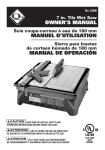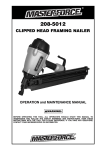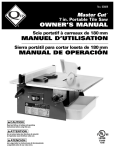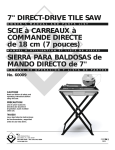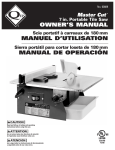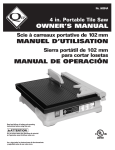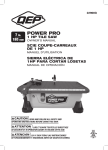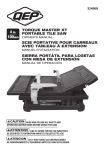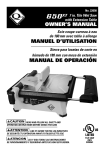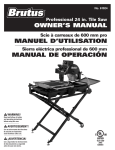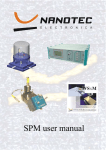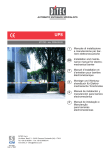Download 8" bridge saw sierra eléctrica tipo puente de 203mm
Transcript
709-3932 8" BRIDGE SAW OWNER’S MANUAL SIERRA ELÉCTRICA TIPO PUENTE DE 203MM MANUAL DE OPERACIÓN READ AND FOLLOW ALL SAFETY AND OPERATING INSTRUCTIONS BEFORE USING THIS SAW. LEA Y SIGA TODAS LAS INSTRUCCIONES DE FUNCIONAMIENTO Y SEGURIDAD ANTES DE USAR ESTA SIERRA. 236418 8" BRIDGE SAW English . . . . . . . . . . . . . . . . . . . . . . . . . . . . . . . . . . . . . . . . . . . . . . . . . . . . . . . . . . . . . . . . . . . page 1 For your own safety, read instruction manual before operating saw. 1. Always wear safety goggles when cutting. 2. Use blade guard for everyoperation for which it can be used. 3. Disconnect saw before cleaning or changing blade. 4. Do not use any cutting blade with openings and grooves. Use only continuous rim blades. 5. R eplace damaged blade before operating. 6. D o not expose to rain or use in damp locations. Limited Warranty — Refer to warranty card. Customer Service: 1-866-435-8665 Español . . . . . . . . . . . . . . . . . . . . . . . . . . . . . . . . . . . . . . . . . . . . . . . . . . . . . . . . . . . . . . . página 23 Lee esta instuccion manual antes de usa la sierra para tu bien. 1. Siempre utilice gafas de protección al cortar. 2. Utilice una capota de protección para cada operación en la cual la puede utilizar. 3. Desconectar la sierra antes de limpiarla o antes de cambiar el disco de corte. 4. No utilice ningún disco de corte que tenga aperturas o ranuras. Solamente utilice discos de corte lisos. 5. Reemplace el disco de corte cuando esté dañado. 6. No la exponga a la lluvia o no la utilice en áreas húmedas. GARANTIA LIMITADA — Referirse a la tarjeta de guarantia. Servicio al cliente: 1-866-435-8665 OWNER’S MANUAL TABLE OF CONTENTS 8. USE THE RIGHT TOOL. Don’t force a tool or attachment to do a job for which it was not designed. 9. USE THE PROPER EXTENSION CORD. Make sure your extension cord is in good condition. When using an extension cord, be sure to use one heavy enough to carry the current your product will draw. An undersized cord will cause a drop in line voltage resulting in loss of power and overheating. Table 1 (page 4) shows the correct size to use depending on cord length and nameplate ampere rating. If in doubt, use the next heavier gauge. The smaller the gauge number, the heavier the cord. 10. Don’t force the tool. It has been designed to operate at maximum safety and performance levels. 11. Do not force the material being cut. Always let the blade cut at its own speed. 12. Wear proper apparel. Do not wear loose clothing, neckties, rings, bracelets or other jewelry which may get caught in moving parts. Non-slip foot wear is recommended. Wear protective hair covering if you have long hair. 13. Always use safety glasses. Also use face or dust mask for commercial cutting operations. Everyday eyeglasses only have impact-resistant lenses, they are NOT safety glasses. 14. Don’t overreach. Keep proper footing and balance at all times. 15. Maintain tools with care. Keep tools clean and in good working condition for maximum safety performance. 16. Disconnect SAW before servicing – when changing accessories, such as blades, bits, cutters, etc. 17. Reduce the risk of unintentional starting. Make sure switch is in OFF position before plugging in. 18. Use recommended accessories. Consult the owner’s manual for recommended accessories. The use of improper accessories may increase risk of injury. General Safety Instructions . . . . . . . . 1-3 Warning . . . . . . . . . . . . . . . . . . . . . . . . . . . 3 Electrical Requirements . . . . . . . . . . . 3-4 Extension Cords . . . . . . . . . . . . . . . . . . . . 4 California Proposition 65 . . . . . . . . . . . . . 4 Description . . . . . . . . . . . . . . . . . . . . . . . . 5 Assembly . . . . . . . . . . . . . . . . . . . . . . . . 5-7 Functional Description and Operation . . . . . . . . . . . . . . . . . . . . 7-9 Maintenance . . . . . . . . . . . . . . . . . . . .9-10 Troubleshooting . . . . . . . . . . . . . . . . 10-11 Parts List . . . . . . . . . . . . . . . . . . . . . . . . . 12 Exploded Parts . . . . . . . . . . . . . . . . . . . . 13 GENERAL SAFETY INSTRUCTIONS Read this owner's manual completely and make sure you understand all of it's safety guidelines. 1. Keep guards in place and in working order. 2. Remove adjusting keys and wrenches. Before turning on the tile saw, make sure the keys and adjusting wrenches have been removed. 3. Keep work area clean. Cluttered areas and benches invite accidents. 4. Always remain alert when the saw is in use. Inattention on the part of the operator may lead to serious injury. 5. Don’t use in a dangerous environment. Don’t use power tools in damp or wet locations or expose them to rain. Keep work area well lit. 6. Keep children away. All visitors should remain at a safe distance from work area. 7. Make workshop child-proof with padlocks, master switches or by removing starter keys. –1– 19. Do not dry cut with blades designed for wet cuts. 20. Make sure you use the correct blade for the job you are doing. 21. Never stand on tool. Serious injury could occur if the wet saw is tipped or if the cutting tool is unintentionally contacted. 22. Check damaged parts. Before further use of the tool, damaged part(s), (i.e., guard) should be carefully checked to determine that it will operate properly and perform its intended function. Check for alignment of moving parts, binding of moving parts, breakage of parts, mounting and any other condition that may affect the saw’s operation. A guard or other part that is damaged should be properly repaired or replaced. 23. Ensure that blade is traveling through water reservoir for wet cutting. 24. Check diamond blades carefully for cracks, nicks, missing diamond matrix or out-of-alignment condition. Replace damaged blades immediately. DO NOT USE DAMAGED BLADES. They may cause bodily injury. 25. Direction of feed. Feed work into the blade against the direction of rotation of the blade only. 26. Do not alter the plug or use a 2-prong receptacle. This saw is equipped with a 3-prong electrical plug. 27. Never leave SAW running unattended. Turn power off. Don’t leave tool until it comes to a complete stop. 28. POSITIONING OF TILE SAW (see Figure 1) • To avoid the possibility of the appliance plug or receptacle getting wet, position the tile saw to one side of a wall-mounted receptacle to prevent water from dripping onto the receptacle or plug. The user should arrange a “drip loop” in the cord connecting the saw to a receptacle. The “drip loop” is that part of the cord below the level of the receptacle, or connector if an extension cord is used, to prevent water traveling along the cord and coming in contact with the receptacle. • If the plug or receptacle does get wet, DO NOT unplug the cord. Disconnect the fuse or circuit breaker that supplies power to the tool. Then, unplug and examine for presence of water in the receptacle. POWER SUPPLY CORD TOOL 4. Improper connection of the equipment-grounding conductor can result in a risk of electric shock. The conductor with insulation that is green on the outside (with or without yellow stripes) is the equipment-grounding conductor. If repair or replacement of the electrical cord or plug is necessary, do not connect the equipment-grounding conductor to a live terminal. 5. Check with a qualified electrician or service personnel if the grounding instructions are not completely understood, or if in doubt as to whether the tool is properly grounded. 6. Use only 3-wire extension cords that have 3-prong grounding plugs and 3-pole receptacles that accept the tile saw’s plug. 7. Repair or replace damaged or worn cord immediately. 8. If the plug or receptacle does get wet, do not unplug the cord. Disconnect the fuse or circuit breaker that supplies power to the tool. Then, unplug and examine for presence of water in the receptacle. 9. Only UL-listed extension cords should be used with this product. 10. Improper use of extension cords may cause inefficient operation of your tool, which can result in overheating. Be sure your extension cord is rated to allow sufficient current flow to the motor. For the proper gauge for this tile saw, please refer to TABLE 1 (page 4). 11. Do not let your fingers touch the terminals of plug when installing or removing the plug to or from the outlet. 12. This tile saw must be properly grounded. The risk of electric shock and bodily injury are greatly increased if it is not, particularly when used in damp locations or in proximity to plumbing. NOTE: This saw is intended for use on a circuit that has a grounded outlet box like the one illustrated in FIGURE 2 (B). This saw has a grounding plug that looks like the one illustrated in FIGURE 2 (A). 13.Never allow the blade to run dry. Failure to keep the water tray at the recommended level will result in possible over-heating of the diamond blade. Warning PERSONAL INJURY CAN OCCUR IF OPERATED IMPROPERLY. DRIP LOOP FIGURE 1 SPECIFIC OPERATION GUIDE 1. Ensure that the directional arrow marked on the blade corresponds with the rotational direction of the motor. 2. With the saw disconnected from the power supply, rotate the blade by hand to ensure it is free from obstruction. 3. Always keep the blade-securing arbor and collars clean. 4. Ensure that the blade-securing bolt is securely tightened. 5. Never try to cut freehand. Always ensure that the tile to be cut is pressed firmly against the rip fence. 6. Ensure that the workpiece that will be cut off has sufficient room to move sideways. Failure to do so may result in the off-cut binding against the blade. 7. Never cut more than one tile at a time. 8. Never cut pieces too small that are not held securely against the rip fence, and provide enough space for the hand to be a safe distance from the blade. 9. Ensure that the table and surrounding area are clear with the exception of the tile to be cut. 10.Before cutting a tile piece, let the saw blade run freely for a few seconds. If it makes an unfamiliar sound or vibrates excessively, switch it off immediately and disconnect it from the power supply. 11.Let the blade reach full speed before commencing the cut. 12.Let the blade come to a complete stop before removing any jammed material from around the blade area. –2– • Keep fingers and loose clothing away from rotating blade. • Use extreme caution when cutting tile. Make sure hands and fingers are clear from the blade groove in the table. Severe abrasion, cuts, or pinching of hands or fingers can occur as the table is advanced, particularly at the end of its travel. • Electrical shock can occur if operating instructions are not followed. FOR YOUR OWN SAFETY READ INSTRUCTION MANUAL BEFORE OPERATING SAW. • Wear eye protection. • Use blade guard for every operation for which it can be used. • Unplug saw before servicing, when changing cutting wheels, and cleaning. • Use tool only with smooth-edge cutting wheels free of openings and grooves. • Replace damaged cutting wheel before operating. • Do not fill water tray above water fill line. ELECTRICAL REQUIREMENTS 1. This tile saw must be connected to a grounded power source while in use to protect the operator from electrical shock. 2. In the event of a malfunction or breakdown, grounding provides a path of least resistance for electrical current to reduce the risk of electrical shock. This tile saw is equipped with an electrical cord with a grounding conductor and a grounding plug. Insert the 3-prong electrical plug into a 3-pole receptacle that is properly installed and grounded in accordance with all local codes and ordinances. 3. Do not modify the plug provided if it will not fit the outlet. Have the proper outlet installed by a qualified electrician. –3– Volts Ampere rating 25 ft. More than No more than 0 6 6 10 120 V Total length of cord in feet 50 ft. 100 ft. AWG 150 ft. 18 16 16 14 16 14 16 12 TABLE 1 cause a drop in line voltage, resulting in loss power and overheating. TABLE 1 shows the correct size to use depending on cord length and nameplate ampere rating. If in doubt, use the next heavier gauge. The smaller the gauge number, the heavier the cord. Note: When using an extension cord, ensure all cords are no smaller than #12 gauge, rated at a 20-amp minimum, and equipped with 3-prong plugs. Use of anything smaller may result in overheating or burn out of the motor. It is recommended to have an electrician check the voltage at the saw motor to ensure proper voltage to run the saw efficiently and safely. Metal screw (A) Grounding pin (B) Grounded outlet box FIGURE 2 EXTENSION CORDS Plunge cutting head for making interior cuts Flexible cord rod keeps encapsulated power cords safely away from the cutting table Steel blade guard accommodates both 8” and 7” blades (8” continuous rim diamond blade included) Adjustable pivoting rail for quick and easy 45° and 90° miter cuts and bevel cuts 1-1/2HP, 10A inductor motor is powerful and long lasting Adjustable pull-out handle Pull-out side extension table supports large format tiles and slabs Universal quick-adjust angle guide and rip fence for quick and accurate miter cuts from 0° to 45° Rubber matting provides a slip resistant working surface Large locking wheels for easy jobsite transport Durable folding stand for convenient storage and transportation Innovative water transport system makes water fill-ups and drainage clean, fast and efficient (requires standard garden hose, sold separately) FIGURE 3 1. Use only extension cords that are intended for outdoor use. These extension cords are identified by a marking “Acceptable for use with outdoor appliances: store indoors while not in use.” Use only extension cords having an electrical rating not less than the rating of the product. Do not use damaged extension cords. Examine extension cord before using and replace if damaged. Do not abuse extension cords and do not yank on any cord to disconnect. Keep cord away from heat and sharp edges. Always disconnect the extension cord from the receptacle before disconnecting the product from the extension cord. CALIFORNIA PROPOSITION 65 Some dust created by power sanding, sawing, grinding, drilling and other construction activities contain chemicals known to the State of California to cause cancer, birth defects or other reproductive harm. Some examples of these chemicals are: • Lead from lead-based paints • Crystalline silica from bricks, cement and other masonry products • Arsenic and chromium from chemicallytreated lumber Your risk from these exposures varies, depending on how often you do this type of work. To reduce your exposure to these chemicals: work in well ventilated area, and work with approved safety equipment, such as those dust masks that are specifically designed to filter out microscopic particles. To reduce the risk of electrocution, keep all connections dry and off the ground. Do not touch plug with wet hands. 2. Ground Fault circuit Interrupter (GFCI) protection should be provided on the circuit(s) or outlet(s) to be used for the tile saw. Receptacles are available having built-in GFCI protection and may be used for this measure of safety. 3. Use proper extension cord. Make sure your extension cord is in good condition. When using an extension cord, be sure to use a cord heavy enough to carry the current your product will draw. An undersized cord will Description Before attempting to use any tool, be sure to familiarize yourself with all the operating features and safety instructions. –4– KNOW YOUR SAW Your tile saw has many built-in features (see figure 3) for fast, efficient cutting of ceramic, porcelain, marble, slate or limestone wall or floor tile. The durable 8 inch blade cuts tile up to 1-1/2 in. thick. The built-in handle allows easy transporting. PRODUCT SPECIFICATIONS Input: 11.3 Amps No-load Speed: 3420 RPM Output: 1-1/3 HP Motor Blade Diameter: 8 in. (203 mm) Arbor: 5/8 in. Rating: 120 Volts~60 Hz AC Depth of Cut: 1 3/8 in. (35 mm) Cutting Capacity: 30" at 90°, 21" at 45° Assembly Follow all of the Assembly and operation Instructions completely before connecting the saw to a power source or turning the motor on. UNPACKING 1. Remove all packing materials from around your saw. –5– 2. Carefully lift the saw from carton and place it on a level work surface. 3. Do not discard the packing materials until you have carefully inspected the saw for loose or damaged parts. The following items are included in box with your tile saw: • Folding stand • Universal Angle Guide • 8 in. premium continuous rim diamond b lade • 2 wrenches •Hex key • Water pump •Water tray •Extension table 4. Inspect the saw carefully to make sure that no breakage or damage has occurred during shipping. If any parts are damaged or missing, return the saw to your place of purchase. If any parts are damaged or missing, DO NOT attempt to operate this saw. Operating this saw with damaged or missing parts could result in possible serious personal injury. 7. Micro adjustment for perfect level. 8. To mount the handle position the handle on the trolley and secure it using the 2 screws (Fig 7). STARTING AND STOPPING 1. Connect the unit to a power supply of the correct voltage and frequency (120V-60HZ). 2. To start the saw press the switch to the “ON” position (Fig 4). 3. To stop the saw, press the switch to the “OFF” position (Fig 4) wood sawing blades, blades with openings, or any other cutting devices with this tile saw. Using these blades could result in serious personal injury and damage to the saw. MAKING A STRAIGHT CUT For your own safety, always position the switch to the “OFF” position when the saw is not in use. In the event of a power failure, blown fuse or tripped circuit breaker, press switch to the “OFF” position. This will prevent the tool from starting up again when the power comes back on. 1. Push the motor trolley away from the operator until it reaches the stroke limit. 2. Position the tile on the cutting table. 3. Properly set the measuring guide and squaring tool (Fig 9). FIGURE 5-1 4. Pull out the stand legs (Fig 5-1). FIGURE 7 5. Stand the saw upright. 9. The motor trolley is secured during shipment, please loosen lever before using (Fig 8). FIGURE 9 FIGURE 4 1. Clean the working area. 2. Remove saw from carton, you will find it assembled. 3. Lay the saw on its side on the ground (Fig 5). FIGURE 5-2 6. Tighten thumb screw to secure legs (Fig 6). 4. Pull the motor trolley slowly towards the material to be cut (Fig 10). FIGURE 8 FILLING THE WATER TRAY AND DRAINING 1. Fill the tray with water between minimum and maximum water line. Do not add chemicals or detergents to the water. 2. To drain, remove the plug from the inside of the tray, the water will flow out or you can remove the tray and pour the water out FIGURE 6 FIGURE 5 The tray can also be filled with the hose attached under the water tray with a gentle flow. FIGURE 10 6. When you have completed the cut push motor trolley/blade away and remove the cut pieces, and any debris on cutting surfaces. Operation Use only continuous rim blades with this saw. DO NOT use segmented, “turbo” blades, –6– –7– 2. REPLACING THE SAW BLADE A. Loosen the blade guard thumb screw (Fig 15). MAKING A DIAGONAL CUT 1. Follow the same procedure for a straight cut. 2. Loosen the nut on the squaring tool, and position the tile diagonally. 3. Lock the nut and perform the cut following procedure for a straight cut. ANGLED OR 45 DEGREE CUTS 1. Loosen the two knobs at either end of the bridge (Fig 11) . Maintenance 3. DO inspect the arbor shaft for uneven wear before mounting the blade. 4. DO use blades with the correct arbor size on a compatible arbor shaft. 5. DO ensure the blade is mounted with the rotation arrow in the proper direction and is securely tightened with a wrench. 6. DO wear proper safety equipment at all times when operating the saw. Wear goggles and dust mask at all times when operating saw. 7. DO periodically check the blade for cracks or bond fatigue. 8. DO ensure that blade is traveling through water reservoir for wet cutting. 9. DO NOT operate the saw without all safety guards in position. 10.DO NOT operate the saw with blades larger or smaller than recommended. 11.DO NOT cut dry with blades marked “Use Wet.” 12.DO NOT exceed maximum RPMs recommended by the blade manufacturer. 13.DO NOT force the material into the blade. Let the blade cut at its own speed. 14.DO NOT cut material not recommended by the blade manufacturer. To avoid accidents, ALWAYS disconnect the tool from the power source BEFORE cleaning or performing any maintenance Please do not try to service this machine on your own. Avoid using solvents when cleaning plastic parts. Most plastics are susceptible to damage from various types of commercial solvents and may be damaged by their use. Use clean cloths to remove dirt, carbon dust, etc. FIGURE 12 FIGURE 11 2. Tilt bridge to the desired angle up to 45 degrees (Fig 13). Tighten knobs at either end of bridge, and proceed with cutting tile following same procedure as listed in the “straight cut” section. C. Use the hexagonal wrench to hold the blade nut and use the spanner wrench provided to hold the shaft. Loosen the nut turning clockwise as in (Fig 13). D. Ensure that the shaft and flanges are clean. Mount blade back on to shaft ensuring that the directional arrow on the blade is rotating towards the material to be cut. E. Insert flange and lock nut. Tighten counterclockwise. CHANGING THE BLADE Disconnect the power supply before making adjustments, maintenance, cleaning or replacing the blade! 1. CHOICE OF THE SAW BLADE. Only use 8 Inch continuous rim or turbo blades with a 5/8 Inch arbor. FIGURE 13 –8– DO NOT at any time let brake fluids, gasoline, petroleumbased products, penetrating oils, etc. come in contact with plastic parts. They contain chemicals that can damage, weaken or destroy plastic. 1. ALWAYS clean the tile saw after each use and store it in a dry location. 2. ALWAYS wipe off all exterior surfaces and keep the cutting table clean and free of all debris. 3. ALWAYS check the blade for cracks or damage BEFORE each use. 4. ALWAYS store the cord in the compartment underneath the saw after each use. TROUBLESHOOTING OVERHEATING OF SAW: 1. Turn saw off and let it rest until motor is cool to the touch. 2. Check and clean the ventilation slots, removing blockage and dirt. DIAMOND BLADES • Use only 8 in. (203 mm) continuous rim diamond blades with a 5/8" arbor opening in this saw. Failure to do so may result in severe bodily injury and damage to the saw. • The diamond blade that comes with this saw will cut ceramic, porcelain and marble tile. Due to the hardness of some porcelain, slate and stone, purchasing a blade specifically designed to cut these hard tiles, will speed up the cutting time required. IMPORTANT: Always let the blade cut at its own speed, moving the material slowly into the blade. Do not force the material being cut. DIAMOND BLADE DO’s & DON’Ts 1. DO inspect blades daily for cracks or uneven wear. Discard cracked, chipped or bent blades! 2. DO use manufacturer’s recommendation for matching the right blade with the right material being cut. THE SAW DOES NOT START: 1. Check that power cord is properly plugged in. 2. Check outlet power source and circuit breaker. 3. Make sure yellow safety key is fully pushed into switch. What to do when the alignment is off on the BRIDGE SAW: The 709-3932 Masterforce 8” Bridge Saw motor or bridge does not need to be squared up or aligned, since the bridge does not allow the saw –9– motor to move. When it appears that the saw is out of alignment, it is the rip fence that needs to be squared up. Tools needed: 24” Framing Square, Phillips Screw Driver and ¼” Nut Driver or Pliers The following steps should be used to align the rip fence for the Bridge Saw: 1. Pull the power unit towards you and lock in place with the transport screw. 2. Once the power unit is secured, place the Framing square firmly against the blade on the left side of the cutting surface. The square must be flush with the blade. (See Image A). 4. To adjust the gap, first remove the Angle cutting guide. This will expose two screws in the aluminum track. Loosen both screws in the extruded aluminum bar. (See Image C & D) 5. From underneath the saw, directly below the rip fence, there are two ¼” bolts located under the left rip fence and 2 bolts under the right rip fence. Loosen both bolts for the rip fence that you are adjusting. (See Images E & F) Right Rip Fence ¼" Bolts IMAGE E Gap 6. Once the screws are loose, easily slide the rip fence above, allowing you to close the gap between the square and the rip fence. When the square is flush against the rip fence re-tighten the two ¼” bolts from the side you are adjusting. If necessary, repeat the same steps for the other side. (See Image G) IMAGE C Rip Fence IMAGE F Left Rip Fence IMAGE AIMAGE B 3. Slide the square into the rip fence, making sure the square stays firmly against the blade. Look for a gap between the square and the rip fence. If there is a gap, adjustments will be necessary. (See Image B) IMAGE G 7. Once both rip fences are secured in place slide the extruded aluminum angle bar firmly against both rip fences and tighten in place for additional support. IMAGE D Customer Service: 1-866-435-8665 – 10 – – 11 – PARTS LIST DESCRIPTION 83250-1 Water Spray Guard QTY PART # DESCRIPTION 1 83250-24 Knob 1 QTY 83250-2 Outer Blade Guard 1 83250-25 Left Rail Stand 1 83250-3 Nut 1 83250-26 Butterfly Knob 1 83250-4 Outside Flange 1 83250-27 Protection Plastic Tube 1 5-8008BW 8 Inch Porcelain Blade 1 83250-28 Resetable Sheet 1 83250-6 Inside Flange 1 83250-29 Slide Rail 1 83250-7 Waterproof Gasket 1 83250-30 Right Rail Slide 1 83250-8 Inside Blade Guard 1 83250-31A Decorated Board 1 83250-9 Handle 1 83250-31B Left Decorated Board 1 83250-10A Motor Fixture 1 83250-31C Right Decorated Board 1 83250-10B Water Pipe Connector 1 83250-32 Table II 1 83250-11 Motor 1 83250-33 Measuring Guide 1 83250-12 Pull-out Handle 1 83250-34 Water Tray 1 83250-13A Decorated Board I 1 83250-35A Front Fence 1 83250-13B Decorated Board II 1 83250-35B Rear Fence 1 83250-14A Left Rail Stand Fixture 1 83250-36 Main Frame 1 83250-14B Right Rail Stand Fixture 1 83250-37 Right Stand 1 83250-15 Water Spray Board 1 83250-38 Foot Pad 1 83250-16 Hex Nut 1 83250-39 Foot Wheel System 1 83250-17 Knob 1 83250-40 Left Stand 1 83250-18A Connecting House 1 83250-41 Butterfly Knob 1 83250-18B Capacitor 1 83250-42 Extension 1 83250-18C Connecting House Cover 1 83250-43 Water Tube 1 83250-18D Switch 1 83250-44 Pump Cable 1 83250-18E Circuit Breaker 1 60098 Cooling Water Pump 1 83250-19 Cable Lock 1 83250-45B O Ring 1 83250-20 Power Cable 1 83250-45C Pump Connector 1 83250-21 Position Bar 1 83250-46 Motor Shaft Wrench 1 83250-22A Lock Bar 1 83250-47 Hexagonal Blade Wrench 1 83250-22B Ball Bearing Trolley 1 83250-23A Spring Shaft 1 83250-23B Punching Cutting System 1 – 12 – EXPLODED PARTS PART # – 13 – SIERRA ELÉCTRICA TIPO PUENTE DE 203MM MANUAL DE OPERACIÓN CONTENIDO Instrucciones generales de seguridad . . 27-28 Advertencia . . . . . . . . . . . . . . . . . . . . . . . . . .28-29 Requerimientos eléctricos . . . . . . . . . . . . . 29-30 Cables de extensión (alargadores) . . . . . . . . . 30 Proposición 65 de California . . . . . . . . . . . . . . 30 Descripción . . . . . . . . . . . . . . . . . . . . . . . . . . 30-31 Montaje . . . . . . . . . . . . . . . . . . . . . . . . . . . . . 31-33 Operación . . . . . . . . . . . . . . . . . . . . . . . . . . . 33-35 Mantenimiento . . . . . . . . . . . . . . . . . . . . . . . 35-36 Localización de averías . . . . . . . . . . . . . . . 36-37 Lista de piezas . . . . . . . . . . . . . . . . . . . . . . . . . . 38 Despiezado . . . . . . . . . . . . . . . . . . . . . . . . . . . . . 39 INSTRUCCIONES GENERALES DE SEGURIDAD Lea este manual del usuario en su totalidad y asegúrese de entender todas las pautas de seguridad. 1. MANTENGA LAS PROTECCIONES EN SU LUGAR y con el orden apropiado para trabajar. 2. REMUEVA LAS LLAVES DE AJUSTE Y LAS LLAVES INGLESAS. Antes de encender la sierra eléctrica para cortar losetas asegúrese que haya quitado las llaves inglesas y las llaves de tuercas de ajuste. 3. MANTENGA LIMPIA SU ÁREA DE TRABAJO. Los accidentes suelen ser más comunes en las áreas que estén desordenadas o por bancas en el área de trabajo. 4. MANTÉNGASE ALERTA AL UTILIZAR LA SIERRA. La falta de atención por parte del operador puede ocasionar accidentes graves. 5. NO LA UTILICE EN AMBIENTES PELIGROSOS. No utilice herramientas eléctricas en lugares húmedos o mojados, ni las exponga a la lluvia. Mantenga bien iluminada el área de trabajo. 6. MANTENGA A LOS NIÑOS ALEJADOS. Todos los visitantes deben mantenerse a una distancia considerable del área de trabajo. 7. ARME SU LUGAR DE TRABAJO A PRUEBA DE NIÑOS, utilizando candados, interruptores principales, o quitando las llaves de encendido. 8. UTILICE LA HERRAMIENTA CORRECTA. No intente utilizar herramientas o accesorios para realizar un trabajo, en el cual la herramienta no ha sido diseñada para esa función. 9. UTILICE UN CABLE DE EXTENSIÓN ADECUADO. Asegúrese de que el cable de extensión está en buenas condiciones. Cuando utilice un cable de extensión, asegúrese de que sea lo suficientemente pesado para transportar la corriente que requerirá el producto. Un cable de menor tamaño al requerido causará una caída en el voltaje de paso y dará como resultado la pérdida de energía y el recalentamiento. La tabla (ver la Tabla 1 en la página 26) muestra el tamaño correcto que debe usarse, teniendo en cuenta la longitud del cable y la clasificación de amperios de la placa de datos. Si tuviera dudas, utilice el siguiente indicador más pesado. Cuanto menor sea el número del indicador, más pesado será el cable. 10. NO FUERCE LA HERRAMIENTA. Ha sido diseñada para funcionar a niveles de máxima seguridad y rendimiento. 11. NO FUERCE EL MATERIAL QUE DEBE CORTAR. Siempre deje que la cuchilla corte a la velocidad para la que fue diseñada. 12. UTILICE UNA VESTIMENTA ADECUADA. No use ropa suelta, corbatas, anillos, pulseras, u otros artículos de joyería que pudieran quedar atrapados en las partes móviles. Se recomienda usar calzado antideslizante. Use una cubierta protectora para el cabello si lo tuviera largo. 13. SIEMPRE USE GAFAS DE PROTECCIÓN. También use máscaras protectoras para la cara y el polvo en el caso de operaciones de corte comercial. Las gafas comunes sólo tienen cristales resistentes a los impactos, pero NO son gafas de seguridad. 14. NO TRATE DE EXTENDERSE MÁS DE LO NECESARIO. Mantenga su posición y el equilibrio en todo momento. 15. MANTENGA LAS HERRAMIENTAS EN BUEN ESTADO. Mantenga las herramientas limpias y en buen estado para trabajar para obtener un máximo rendimiento de seguridad. – 14 – 16. DESCONECTE LA SIERRA ELÉCTRICA ANTES DE HACERLE ALGÚN ARREGLO – al cambiar accesorios, como cuchillas, puntas, elementos cortantes, etc. 17. REDUZCA EL RIESGO DE UN ENCENDIDO INVOLUNTARIO. Asegúrese de que la herramienta se encuentra en posición de APAGADO antes de enchufarla. 18. UTILICE LOS ACCESORIOS RECOMENDADOS. Consulte el manual del usuario para los accesorios recomendados. El uso de accesorios inadecuados puede ocasionar accidentes. 19. NO REALICE CORTES EN SECO CON DISCOS DE DIAMANTE DISEÑADOS PARA REALIZAR CORTES CON AGUA. 20. ASEGÚRESE DE USAR LA CUCHILLA CORRECTA para el trabajo que está realizando. 21. NUNCA SE APOYE SOBRE LA HERRAMIENTA. Puede tener un accidente grave si la herramienta se mueve o si se toma contacto involuntario con la parte cortante. 22. REVISE LAS PARTES DAÑADAS. Antes de volver a utilizar la herramienta debe revisar cuidadosamente la(s) parte(s) dañada(s), (por ejemplo la protección), para saber si funcionará en forma adecuada y cumplirá con su función. Revise la alineación de las partes móviles, la unión de las mismas, si se rompieron, superpusieron y cualquier otra condición que pueda afectar el funcionamiento de la sierra. Las protecciones u otras partes que estén dañadas deben repararse o reemplazarse adecuadamente. 23. Asegúrese que el DISCO DE CORTE ESTÉ PASANDO A TRAVÉS DE LA RESERVA DE AGUA PARA OBTENER UN CORTE EN HÚMEDO. 24. REVISE CUIDADOSAMENTE LOS DISCOS DE DIAMANTE en caso de grietas, rajaduras, que la matriz de diamante falte o que esté desalineado. Reemplace las cuchillas dañadas inmediatamente. NO USE DISCOS DAÑADOS. Pueden causar accidentes graves. 25. DIRECCIÓN DE LA ALIMENTACIÓN. Solamente coloque el trabajo en la cuchilla en dirección contraria a la rotación de la cuchilla. 26. NO ALTERE EL ENCHUFE O USE UN TOMACORRIENTE DE 2 PUNTAS. Esta sierra está equipada con un enchufe eléctrico de 3 puntas. 27. NUNCA DEJE LA SIERRA ELÉCTRICA ENCENDIDA SIN PRESTARLE ATENCIÓN. Apáguela. No deje la herramienta hasta que se haya detenido completamente. 28. COLOCACIÓN DE LA SIERRA ELÉCTRICA PARA LOSETAS (ver el FIGURA 1) CABLE DE ALIMENTACIÓN ELÉCTRICA SIERRA PARA LOSETA VUELTA DE GOTEO FIGURA 1 • Para evitar que el tomacorriente o enchufe del accesorio se humedezcan, coloque la sierra eléctrica para losetas hacia un lado del tomacorriente que se encuentra en la pared, para que el agua no caiga sobre éste o el enchufe. El usuario debería realizar una "vuelta de goteo" en el cable que conecta la sierra al tomacorriente. La "vuelta de goteo" es la parte del cable por debajo del nivel del tomacorriente, o el conector si se utiliza un cable de extensión, que evita que el agua se deslice por el cable y entre en contacto con el tomacorriente. • Si el enchufe o el tomacorriente se humedecieren, no desenchufe el cable. Desconecte el fusible o el interruptor automático que suministra electricidad a la herramienta. Luego desenchúfela y revise si hay agua en el tomacorriente. ADVERTENCIA EL USO INADECUADO PUEDE OCASIONAR GRAVES ACCIDENTES. • Mantenga los dedos y la ropa que esté suelta alejados del disco de diamante giratorio. • Sea sumamente cuidadoso al cortar losetas. Asegúrese de que las manos y los dedos estén alejados de la ranura de la cuchilla en la mesa. Puede rasparse, cortarse o apretarse los dedos gravemente mientras la mesa está en movimiento, generalmente al finalizar su trayectoria. • Si no se siguen las instrucciones de funcionamiento puede producirse una descarga eléctrica. PARA SU SEGURIDAD LEA EL MANUAL DE INSTRUCCIONES ANTES DE PONER EN FUNCIONAMIENTO LA SIERRA. – 15 – • Use protección para los ojos. • Use una máscara protectora siempre que sea necesario. • Desconecte la sierra antes de hacerle alguna reparación, cuando le cambie los discos de diamante, y antes de limpiarla. • Use la herramienta sólo con discos de diamantes que tengan los de bordes libres de aberturas y ranuras. • Reemplace el disco de diamante que esté dañado antes de poner la sierra en funcionamiento. • No llene la bandeja de agua por encima de la línea marcada para llenarlo. REQUERIMIENTOS ELÉCTRICOS 6. UTILICE SOLAMENTE CABLES DE EXTENSIÓN DE 3 CONDUCTORES que poseen enchufes de conexión polo a tierra de 3 puntas y tomacorrientes de 3 polos que aceptan el enchufe de la sierra eléctrica para cortar losetas. 7. REPARE O REEMPLACE INMEDIATAMENTE EL CABLE GASTADO O DAÑADO. 8. SI EL ENCHUFE O TOMACORRIENTE SE HUMEDECIERAN, NO DESENCHUFE EL CABLE. Desconecte el fusible o el interruptor automático que suministra electricidad a la herramienta. Luego desenchúfela y revise si hay agua en el tomacorriente. 9. CON ESTE PRODUCTO SÓLO PUEDEN USARSE CABLES DE EXTENSIÓN CALIFICADOS POR UL. 10. EL USO INADECUADO DE CABLES DE EXTENSIÓN PUEDE PRODUCIR UN FUNCIONAMIENTO DEFICIENTE DE LA HERRAMIENTA, que puede dar como resultado el recalentamiento. Asegúrese de que el cable de extensión tenga la potencia adecuada para suministrar una corriente eléctrica suficiente al motor. Para calibrar su herramienta en forma adecuada consulte el TABLA 1 (página 26). 11. NO TOQUE CON LOS DEDOS las terminales del enchufe al conectar o desconectar el enchufe del toma. 12. ESTA SIERRA ELÉCTRICA PARA CORTAR LOSETAS DEBE SER INSTALADA APROPIADAMENTE POLO A TIERRA. Si no lo estuviera aumentaría enormemente el riesgo de descargas eléctricas y accidentes, particularmente si se utilizara en lugares húmedos o cercanos a cañerías. NOTA: La sierra electrica professional esta diseñada para ser conectada en un toma corriente empotrado y conectado a tierra como el que se encuentra en la FIGURA 2(B). Ademas esta sierra tiene un toma corriente de tierra como el de la FIGURA 2(A). 1. ESTA SIERRA ELÉCTRICA PARA LOSETAS DEBE TENER UNA CONEXIÓN POLO A TIERRA mientras está en uso para evitar que el operador sufra una descarga eléctrica. 2. EN EL CASO DE MAL FUNCIONAMIENTO O FALLA ELÉCTRICA, la conexión polo a tierra proporciona un suministro de menor resistencia de corriente eléctrica para reducir el riesgo de una descarga eléctrica. Esta herramienta está equipada con un cable eléctrico con un conductor con conexión polo a tierra y un enchufe con conexión polo a tierra. Conecte el enchufe eléctrico de 3 puntas a una toma de 3 polos debidamente instalado y con una conexión polo a tierra conforme a los códigos y regulaciones locales. 3. NO MODIFIQUE EL ENCHUFE SUMINISTRADO si éste no se adapta la toma. Instale la toma adecuado con la ayuda de un electricista profesional. 4. LA CONEXIÓN INADECUADA DEL CONDUCTOR CON LA CONEXIÓN POLO A TIERRA DEL EQUIPO PUEDE OCASIONAR UNA DESCARGA ELÉCTRICA. El conductor con aislamiento que posee una superficie externa verde (con o sin franjas amarillas) es el conductor de conexión polo a tierra del equipo. Si fuera necesario reparar (A) Pernos o reemplazar el cable eléctrico o enchufe no de tierra conecte el conductor de conexión polo a tierra del equipo a una terminal activa. 5. CONSULTE A UN ELECTRICISTA PROFESIONAL si no entendiera completamente las instrucciones para la conexión polo a tierra; o si tuviera dudas FIGURA 2 acerca de si la herramienta está conectada correctamente polo a tierra. – 16 – Tornillo de metal (B) Toma corriente empotrado y conectado a tierra Voltios Régimen de amperios Más de No más de 0 6 6 10 7,62 m 120 V 18 16 Longitud total del cable en pies 15,24 m 30,48 m 45,72 m AWG 16 16 14 14 16 12 TABLA 1 CABLES DE EXTENSIÓN (ALARGADORES) un calibre menor al # 12, con una potencia de 20-amperios como mínimo, y estén equipados con enchufes de 3 puntas. El uso de cualquier cable menor puede ocasionar el recalentamiento o que se queme el motor. Se recomienda que un electricista revise el voltaje en el motor de la sierra para asegurarse de que tiene el voltaje adecuado para que la sierra funcione de manera eficaz y segura. 1. Utilice solamente los cables de extensión destinados para uso en áreas exteriores. Puede identificarlos con la leyenda “Pueden usarse con dispositivos para exteriores: guardar en el interior cuando no se use.” Utilice solamente los cables de extensión que tengan una clasificación eléctrica no menor a la clasificación del producto. No utilice el cable de extensión si está dañado, reemplácelo. Examine el cable de extensión antes Proposición 65 de California de usarlo y suspenda el uso si está dañado. No maltrate el cable de extensión y no lo desconecte de un tirón. Mantenga el cable alejado del calor Algunos y los bordes filosos. Siempre desconecte el polvos creados por lijadoras cable de extensión del tomacorriente antes de mecánicas, aserraderos, trituradores, desconectar el producto del cable de extensión. perforadoras y otras actividades de construcción contienen sustancias Para reducir químicas que se sabe (en el Estado de el riesgo de electrocución, mantenga California) causan cáncer, defectos de todas las conexiones secas y lejos nacimiento u otros daños al sistema del suelo. No toque el enchufe con las reproductivo. manos mojadas. Algunos ejemplos de estas sustancias químicas 2. El/los circuito/s o toma/s que se usarán con la son: sierra para losetas/azulejos deben contener un • Plomo derivado de pinturas a base de plomo. Interruptor de Circuito Polo a Tierra (GFCI) como • Sílice cristalino de los ladrillos, cementos y protección. Se pueden obtener tomacorrientes otros tipos de productos de albañería. con protección GFCI incorporada para usarse de • Arsénico y cromo de madera tratada con acuerdo con esta medida de seguridad. sustancias químicas. 3. UTILICE UN CABLE DE EXTENSIÓN El riesgo de exposición a éstas situaciones varía, ADECUADO. Asegúrese de que el cable de dependiendo de cuantas veces se hace este extensión esté en buenas condiciones. Cuando tipo de trabajo. Para reducir el contacto con utilice un cable de extensión, asegúrese de que estas sustancias químicas: trabaje en lugares sea lo suficientemente pesado para transportar la corriente que requiera el producto. Un cable de bien ventilados y con equipos aprobados para tamaño reducido causará una caída en el voltaje la protección, como mascarillas para el polvo que son diseñadas especificamente para filtrar de paso, y dará como resultado la pérdida de energía y el recalentamiento. La TABLA muestra partículas microscopias. el tamaño correcto que debe usarse, teniendo en cuenta la longitud del cable y la clasificación de amperios en la placa de datos. Si tuviera dudas, Descripción utilice el siguiente indicador más pesado. Cuanto Antes de intentar utilizar cualquier herramienta menor sea el número del indicador, más pesado asegúrese que esté familiarizado con todas será el cable. las características de operación y con las NOTA: Cuando utilice un cable de extensión, instrucciones de seguridad. asegúrese de que todos los cables no tengan – 17 – CONOZCA SU SIERRA Su sierra para cortar losetas tiene muchas características integradas (ver la Figura 3) para cortar rápidamente y eficientemente cerámica, porcelana, mármol, pizarra, piedra caliza para pared o losetas para piso. El disco de corte de 180 mm es de larga duración, corta losetas que tengan un grosor hasta de 31 mm. ESPECIFICACIONES DEL PRODUCTO Entrada: 11.3 Amperios Velocidad sin carga: 3420 RPM Salida: 1-1/3 máximo de cabllos de fuerza Diámetro del disco de corte: 203 mm Eje: 16 mm Rango: 120 Voltios, 60 Hercios Profundidad del Corte: 35 mm Capacidad del Corte: 762mm at 90°, 533mm at 45° Montaje Siga todas las instrucciones acerca del montaje e instalación que están en éste manual, antes de conectar la sierra para cortar losetas en la toma eléctrica y encenderla. Varilla flexible para los cables mantiene los cables eléctricos encapsulados y seguros, lejos de la mesa de corte DESEMPAQUE 1. Remueva todos los materiales de empaque que están alrededor de su sierra. 2. Con cuidado levante la sierra y sáquela del cartón colocándola en una superficie que esté al nivel para trabajar. 3. No deseche los materiales de empaque hasta que usted no haya inspeccionado bien la sierra si llegará a tener alguna parte suelta o dañada. Los siguientes artículos están incluidos en la caja con su sierra para cortar losetas: • Soporte plegable • Guía universal para ángulos • Disco de corte diamantado de banda continua de 200 mm de calidad superior • 2 Llaves inglesas • Llave hexagonal • Bomba para el agua • Bandeja para el agua • Mesa de extensión 4. Inspeccione cuidadosamente la sierra para asegurarse que durante el transporte no se haya roto a dañado. Si alguna parte está dañada o le falta alguna parte regrese la sierra al lugar donde la compró. Cabeza para cortes penetrantes para realizar cortes interiores Riel pivoteable y ajustable para realizar fácilmente cortes a inglete y biselados a 45° y 90° Motor de inducción de 1-1/2HP, 10A es potente y duradero Manija retirada ajustable Mesa de extensión lateral extraíble proporciona soporte para las losetas grandes y las lajas Almohadilla de caucho proporciona una superficie de trabajo resistente a los deslizamientos Ruedas bloqueables grandes para transportarla fácilmente en el área de trabajo Protección en acero, para el disco de corte acomoda discos de corte de 200 mm y de 180 mm (Se incluye un disco de corte diamantado de banda continua de 200 mm) Soporte plegable muy duradero para un almacenamiento y transportación conveniente FIGURA 3 Si alguna parte está dañada o le hace falta, NO intente utilizar esta sierra. Si utiliza esta sierra con alguna parte dañada o sin una parte que le haga falta, podría resultar en una seria lesión personal. ARRANQUE Y PARADA 1. Conecte la unidad a una fuente de energía de voltaje y corriente correctos (120V-60HZ). 2. Para arrancar la sierra coloque el interruptor en la posición “ON” (Fig. 3). 3. Para detener la sierra, coloque el interruptor en la posición “OFF” (Fig. 3). Para su propia seguridad, siempre coloque el interruptor en la posición “OFF” cuando no utilice la sierra. En el caso de un corte de energía, fusible fundido o cortacircuito desconectado, coloque el interruptor en la posición “OFF”. Evitará que la herramienta vuelva a arrancar cuando se restablezca el suministro de energía. FIGURA 5-1 4. Saque las patas del estante 5. Coloque la sierra en posición vertical. FIGURA 5-2 6. Tornillo de ajuste con el dedo pulgar, para asegurar las patas. (Fig 5-2). FIGURA 4 1. Limpie el área de trabajo. 2. Retire la sierra de la caja de cartón, la encontrará armada. 3. Apoye la sierra sobre un costado en el suelo (Fig 5). Guía universal para ángulos de ajuste rápido y tope-guía para realizar cortes rápidos y precisos a inglete desde 0° a 45° FIGURA 6 Innovador sistema para transportar el agua permite rellenar con agua y drenar el agua de una manera limpia, rápida y eficiente (Requiere de 7. Micro ajustes para una nivelación perfecta. (Fig 6). una manguera estándar de jardinería, se vende por separado) FIGURA 5 – 18 – – 19 – OperaCIÓN 8. Para montar la empuñadura, colóquela sobre el carro y asegúrela mediante 2 tornillos (Fig 7). Con esta sierra, solamente utilice discos de corte con banda continua. NO utilice discos de corte con banda segmentada, turbo, para cortar madera, con aberturas o con ningún otro artículo para cortar con esta sierra. Si utiliza éste tipo de discos de corte podría causar lesiones personales muy serias y dañar la sierra. FIGURA 7 PARA HACER UN CORTE DIAGONAL 1. Siga el mismo procedimiento que para hacer un corte recto. 2. Afloje la tuerca de la herramienta para escuadrar y coloque la loseta en posición diagonal (Fig. 12). 3. Trabe la tuerca y realice el corte siguiendo el procedimiento para un corte recto. CORTES EN ÁNGULO O A 45 GRADOS 1.Afloje las dos perillas de cualquiera de los extremos del puente (Fig 12). PARA HACER UN CORTE RECTO 1. Empuje el carro del motor lejos del operador hasta que llegue al límite de la carrera. 2. Coloque la loseta sobre la mesa de corte. 3. Coloque correctamente la guía de medición y la herramienta para escuadrar (Fig 9). 9. El carrillo del motor se mantiene asegurado durante su transporte, por favor afloje la palanca antes de utilizarlo. (Fig 8). FIGURA 15 FIGURA 12 FIGURA 9 2. Incline el puente al ángulo deseado hasta los 45 grados (Fig. 13). Ajuste las perillas a ambos extremos del puente y corte la loseta siguiendo el mismo procedimiento que se describe en la sección de “corte recto”. 4. Empuje el carro del motor lentamente hacia el material a cortar (Fig 11). CAMBIO DEL DISCO FIGURA 8 LLENADO Y DESAGOTE DE LA BANDEJA PARA AGUA 1. Llene la bandeja con agua entre la línea que marca mínimo y la línea que marca máximo. No agregue ningún químico ni detergente al agua. 2. Para el drenaje, remueva el tapón que está dentro de la bandeja, el agua fluirá hacia afuera o usted también podrá remover la bandeja y dispersar el agua hacia afuera. También podrá rellenar la bandeja con la manguera adjuntada debajo de la bandeja, utilizando un flujo leve. 2. REEMPLAZO DEL DISCO DE LA SIERRA A. Retire la protección del disco quitando los 2 tornillos (Fig 15). C. Utilice la llave hexagonal para sostener la tuerca del disco y use la llave con salientes suministrada para sujetar el eje. Afloje la tuerca girándola en el sentido de las agujas del reloj como se muestra en la (Fig 16). D. Asegúrese de que el eje y las pestañas estén limpios. Monte la parte posterior del disco sobre el eje, asegurándose de que la flecha direccional del disco rote en dirección al material a cortar. E. Introduzca la pestaña y trabe la tuerca. Ajústela en sentido contrario a las agujas del reloj. ¡Desconecte la fuente de energía antes de hacer ajustes, realizar el mantenimiento, limpiar o reemplazar el disco! 1. ELECCIÓN DEL DISCO DE LA SIERRA. Únicamente use discos de borde continuo o turbo de 203 mm con un mandril de sujeción de 159 mm. FIGURA 11 FIGURA 16 5. Una vez que haya completado el corte, aleje el carro del motor/disco, y retire las piezas cortadas y cualquier residuo que haya sobre las superficies de corte. – 20 – – 21 – MANTENIMIENTO moviendo el material lentamente hacia el disco de corte. No fuerce el material que esté cortando. Para evitar accidentes, SIEMPRE desconecte la sierra de la fuente de electricidad ANTES de limpiarla o hacerle algún mantenimiento. QUÉ HACER Y QUÉ NO HACER CON EL DISCO DE DIAMANTE 1. Revisar los discos de diamante diariamente en caso de roturas o desgaste desparejo. ¡No utilizar discos de diamante rotos, astilladas o dobladas! 2. Seguir siempre las recomendaciones del fabricante para utilizar la cuchilla adecuada para el material que se desea cortar. 3. Revisar el eje en caso de desgaste desparejo antes de colocar el disco de diamante. 4. Usar siempre discos de diamante con el tamaño de eje adecuado en un eje compatible. 5. Asegurarse de que se colocó el disco de diamante con la flecha de rotación en la dirección correcta y que está sujeto firmemente con la llave de tuerca. 6. Usar siempre el equipo de seguridad adecuado al operar la sierra. Usar gafas protectoras y máscara para el polvo en todo momento. 7. Revisar periódicamente la cuchilla en caso de roturas o fatiga del material. 8. Asegúrese que el disco de corte esté pasando a través de la reserva de agua para realizar el corte en húmedo. 9. No opere la sierra sin colocar todos los elementos de seguridad en posición. 10.No use la sierra con discos de diamante más grandes o más pequeños que los recomendados. 11.No haga cortes en seco con cuchillas marcadas para “Usar con Agua”. 12.No exceda del máximo de RPM recomendadas por el fabricante de la cuchilla. 13.No fuerce el material dentro de la cuchilla. Dejar que la cuchilla corte a su propia velocidad. 14.No corte materiales distintos a los recomendados por el fabricante de la cuchilla. Por favor no intente hacerle algún servicio a esta sierra usted solo. Evite utilizar solventes cuando esté limpiando las parte plásticas. La mayoría de las partes plásticas son susceptibles a dañarse a causa de varios tipos de solventes comerciales y también podrían dañarse por su uso. Utilice un trapo limpio para remover mugre, polvo etc. NUNCA permita que líquidos para frenos, gasolina, productos a base de petróleo, aceites penetrantes etc., entren en contacto con las partes plásticas. Estos contienen químicos que pueden dañar, debilitar o destruir plástico. 1. SIEMPRE limpie la sierra para losetas después de cada uso y guarde la sierra para losetas en un área seca. 2. SIEMPRE limpie todas las superficies exteriores y mantenga la mesa de corte limpia y libre de desechos. 3. SIEMPRE revise el disco de corte a ver si tiene grietas o demuestra algún signo de estar dañado ANTES de cada uso. 4. SIEMPRE guarde el cable en el compartimiento que está en la parte de abajo de la sierra después de cada uso. DISCOS DE DIAMANTE • Utilice en esta sierra solamente un disco de diamante de banda continua de 180 mm con un apertura de eje de 16 mm. De no ser así podría resultar en causarse daños físicos o dañar la sierra. • El disco de corte diamantado que viene con ésta sierra cortará losetas de cerámica, porcelana y mármol. Dado a la dureza de la porcelana, la pizarra y la piedra, puede comprar un disco de corte específicamente diseñado para estos materiales, para acelerar el tiempo de corte requerido. IMPORTANTE: Siempre permita que el disco de corte haga el corte a su propio ritmo, – 22 – LOCALIZACIÓN DE AVERÍAS Cerca para corte recto SOBRECALENTAMIENTO DE LA SIERRA: 1. Apague la sierra eléctrica tipo puente y déjela en reposo hasta que el motor esté frío al tacto. 2. Verifique y limpie las ranuras de ventilación, quite cualquier obstrucción y suciedad. LA SIERRA NO ARRANCA: 1. Verifique que el cable de alimentación esté enchufado correctamente. 2. Revise la fuente de energía de la toma eléctrica y el corta circuito. 3. Asegúrese que la llave amarilla de seguridad esté completamente empujada hacia el interruptor. Qué hacer cuando la sierra Sierra Eléctrica Tipo Puente está desalineada: El motor o el puente de la sierra eléctrica de puente 709-3932 Masterforce Sierra Eléctrica Tipo Puente de 203mm no requieren ser escuadrados o alineados, ya que el puente no permite que el motor se mueva. Cuando la sierra aparente estar desalineada, es la cerca para corte recto que debe ser escuadrada. Herramientas requeridas: Escuadra de 60 cm Destornillador Phillips Aprieta tuercas de 6 mm o unas pinzas Brecha IMAGEN AIMAGEN B 3. Deslice la escuadra en la cerca para corte recto, asegurándose que la escuadra quede firmemente contra la cuchilla. Busque a ver si hay vacíos entre la escuadra y la cerca para corte recto. Si hay vacíos deberá realizar ajustes. (Ver la imagen B) 4. Para ajustar el vacío, primero remueva la guía para corte en ángulo. Esto expondrá los dos tornillos en el tramo de aluminio. Afloje ambos tornillos que están en la barra de aluminio extruido. (Ver la imagen C y D) Deberá seguir los siguientes pasos para alinear la cerca para corte recto de la Sierra Eléctrica Tipo Puente: 1. Jale la unidad de potencia hacia usted y bloquéela en su lugar, utilizando el tornillo de transporte. 2. Una vez haya asegurado la unidad de potencia, coloque la escuadra firmemente contra el disco de corte, en el costado izquierdo de la superficie de corte. La escuadra deberá quedar a ras con el disco de corte. (Ver la imagen A) – 23 – Cerca para corte recto a la derecha 6. Una vez haya aflojado los tronillos, deslice fácilmente la cerca para corte recto de arriba, permitiéndole cerrar el vacío entre la escuadra y la cerca para corte recto. Cuando la escuadra se encuentre a ras contra la cerca para corte recto, vuelva ajustar los dos pernos de 6 mm del costado que se encuentre ajustando. Si es necesario, repita los mismos pasos para el otro costado. (Ver las imágen G) IMAGEN C Cerca para corte recto a la izquierda IMAGEN D 5. Desde la parte de debajo de la sierra, directamente debajo de la cerca para corte recto, hay dos pernos de 6 mm ubicados debajo de la cerca de corte recto del lado izquierdo y 2 pernos debajo de la cerca de corte recto del lado derecho. Afloje ambos pernos de la cerca de corte recto que usted está ajustando. (Ver la imágenes E y F) IMAGE G 7. Una vez ambas cercas para corte recto estén aseguradas en su lugar, deslice la barra angular de aluminio extruido firmemente contra ambas cercas para corte recto y apriete en su lugar para obtener soporte adicional. Servicio al cliente: 1-866-435-8665 IMAGEN E Pernos de 6 mm LISTA DE PIEZAS Ver el diagrama de las partes en la página 26. PIEZA DESCRIPCIÓN Cant. 83250-1 Protección contra salpicaduras de agua 1 83250-2 Protector exterior del disco 1 83250-3 Tuerca 1 83250-4 Pestaña externa 1 5-8008BW Disco de diamante de 203mm 1 83250-6 Pestaña interna 1 83250-7 Junta impermeable 1 83250-8 Protector interior del disco 1 83250-9 Manija 1 83250-10A Fijación del motor 1 83250-10B Conector para tubo de agua 1 83250-11 Motor 1 83250-12 Manija retirada ajustable 1 83250-13A Tablero decorado I 1 83250-13B Tablero decorado II 1 83250-14A Fijación del soporte del riel izquierdo 1 83250-14B Fijación del soporte del riel derecho 1 83250-15 Tablero para rocío de agua 1 83250-16 Tuerca hexagonal 1 83250-17 Perilla 1 83250-18A Manguera de conexión 1 83250-18B Capacitor 1 83250-18C Cubierta para manguera de conexión 1 83250-18D Interruptor 1 83250-18E Cortacircuito 83250-19 PIEZA DESCRIPCIÓN Cant. 83250-23B Sistema de corte por punzonado 1 83250-24 Perilla 1 83250-25 Soporte del riel - izquierdo 1 83250-26 Perilla mariposa 1 83250-27 Protección para tubo de plástico 1 83250-28 Hoja reajustable 1 83250-29 Riel de deslizamiento 1 83250-30 Riel de deslizamiento - derecho 1 83250-31A Tablero decorado 1 83250-31B Tablero decorado - izquierdo 1 83250-31C Tablero decorado - derecho 1 83250-32 Mesa II 1 83250-33 Guía de medición 1 83250-34 Bandeja para agua 1 83250-35A Valla frontal 1 83250-35B Valla trasera 1 83250-36 Bastidor principal 1 83250-37 Soporte derecho 1 83250-38 Almohadilla de pata 1 83250-39 Sistema de ruedas de pie 1 83250-40 Soporte izquierdo 1 83250-41 Perilla mariposa 1 83250-42 Extensión 1 83250-43 Tubo de agua 1 83250-44 Cable de la bomba 1 60098 Bomba de agua 1 1 83250-45B Anillo toroidal de goma 1 Cable de bloqueo 1 83250-45C Conector de la bomba 1 83250-20 Cable de energía eléctrica 1 83250-46 Llave del eje del motor 1 83250-21 Barra de posición 1 83250-47 Llave hexagonal para discos 1 83250-22A Barra de bloqueo 1 83250-22B Bola carro que lleva 1 83250-23A Eje de resorte 1 IMAGEN F – 25 – NOTES | NOTAS DESPIEZADO ________________________________________________________________ ________________________________________________________________ ________________________________________________________________ ________________________________________________________________ ________________________________________________________________ ________________________________________________________________ ________________________________________________________________ ________________________________________________________________ ________________________________________________________________ ________________________________________________________________ ________________________________________________________________ ________________________________________________________________ ________________________________________________________________ ________________________________________________________________ ________________________________________________________________ ________________________________________________________________ ________________________________________________________________ ________________________________________________________________ ________________________________________________________________ ________________________________________________________________ ________________________________________________________________ ________________________________________________________________ ________________________________________________________________ ________________________________________________________________ ________________________________________________________________ ________________________________________________________________ ________________________________________________________________ ________________________________________________________________ ________________________________________________________________ ________________________________________________________________ ________________________________________________________________ – 26 – – 27 – NOTES | NOTAS NOTES | NOTAS ________________________________________________________________ ________________________________________________________________ ________________________________________________________________ ________________________________________________________________ ________________________________________________________________ ________________________________________________________________ ________________________________________________________________ ________________________________________________________________ ________________________________________________________________ ________________________________________________________________ ________________________________________________________________ ________________________________________________________________ ________________________________________________________________ ________________________________________________________________ ________________________________________________________________ ________________________________________________________________ ________________________________________________________________ ________________________________________________________________ ________________________________________________________________ ________________________________________________________________ ________________________________________________________________ ________________________________________________________________ ________________________________________________________________ ________________________________________________________________ ________________________________________________________________ ________________________________________________________________ ________________________________________________________________ ________________________________________________________________ ________________________________________________________________ ________________________________________________________________ ________________________________________________________________ ________________________________________________________________ ________________________________________________________________ ________________________________________________________________ ________________________________________________________________ ________________________________________________________________ ________________________________________________________________ ________________________________________________________________ ________________________________________________________________ ________________________________________________________________ ________________________________________________________________ ________________________________________________________________ ________________________________________________________________ ________________________________________________________________ ________________________________________________________________ ________________________________________________________________ ________________________________________________________________ ________________________________________________________________ ________________________________________________________________ ________________________________________________________________ ________________________________________________________________ ________________________________________________________________ ________________________________________________________________ ________________________________________________________________ ________________________________________________________________ ________________________________________________________________ ________________________________________________________________ ________________________________________________________________ ________________________________________________________________ ________________________________________________________________ ________________________________________________________________ ________________________________________________________________ – 28 – – 29 – Made in China Fabriqué en Chine Hecho en China Boca Raton, FL 33487 www.qep.com A0315-9167 – 30 –

















